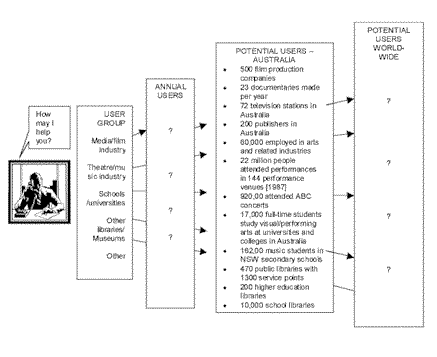ACTING
ON A NEW STAGE:
performing arts information management in New South Wales
6 PERFORMING ARTS INFORMATION MANAGEMENT IN NSW
6.3 Users, services and products
6.31 Users
Most services are driven by well-developed
professional intuitions derived from day-to-day interactions with customers
rather than systematic capture and analysis of data.
The Dennis Wolanski Library managed about 12,000
information transactions a year, including about 3000 reference enquires,
90% of which were from external users, grouped as follows:
-
Performing arts industry including
the media, publishing, theatre, music and dance organisations, film and
TV producers and a range of individual professionals associated with
these groups [e.g. actors, writers, designers].
-
Educational institutions, teachers
and students, from primary to university levels.
-
General public and other miscellaneous
groups including government and private sector organisations.
-
Libraries including national, state
and special libraries acting on behalf of the above groups
At the State Library of NSW, based on 1991
figures, the number of performing arts and music enquiries is estimated to
be 22,500 [out of a total number of 450,000 enquiries].
6.32 Services
Services by libraries participating in this
survey are largely confined to the provision of access to collections,
assistance with user enquiries, provision of photocopying services and, in
some cases, inter-library loan services. The catalogues of some libraries -
the State Library of NSW and the University of NSW are searchable via Web
sites.
6.33 Processes
Users approach libraries by phone, letter,
e-mail or fax or by making a visit to the library. Sometimes they contact
several libraries in pursuit of the same information and the process of
providing the service is repeated in each library.
Usually these responses are not captured or
preserved for re-use in the future. The details relating to the enquiry are
simply filed away or retained as vague memories in the minds of those
assisting with the enquiry.
6.34 Products
The Dennis Wolanski Library made $35,000 a year
from services and products. There is potential for developing
income-generating services and products in individual libraries and through
collaborative projects.
6.35 Market information

The above model is an incomplete, out-of-date
representation of library users and commercial prospects. All performing
arts libraries and collections would benefit from the development of a more
authoritative map and improved quantitative and qualitative information on
library users who they are, why they use the libraries, what difficulties
they experience, whether they were wholly or partly satisfied, why potential
users dont use them. The development of systems for capturing user
information, including regular surveys, would help individual institutions
to fine-tune their operations as well as provide fuel for collaborative
decision-making.
These systems could also make intellectual
capital out of responses to user enquiries particularly written responses
resulting in efficiencies across libraries through the elimination of
duplicated work.